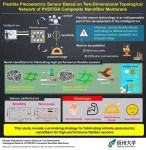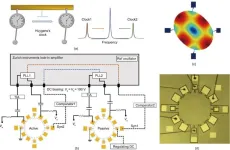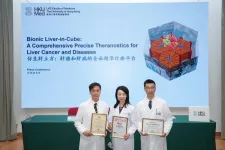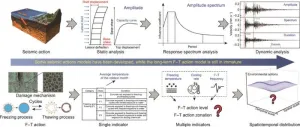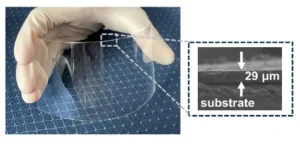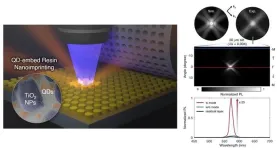(Press-News.org) There are various types of widow spiders, including black, red, and brown varieties in North and South America, the Australian redback spider, and several button spider species that inhabit South Africa. In Europe, Latrodectus tredecimguttatus – the European black widow – inhabits the Mediterranean region, but recently and due to the changing climate, the widows have been expanding their habitat.
Widow spiders’ bites can cause latrodectism, a disease where the spider’s venom, a neurotoxin known as alpha-latrotoxin, attacks the nervous system and causes symptoms like severe pain, hypertension, headache, and nausea. Black widow bites can be treated with antibodies derived from horses, but to make treatment safer for patients, researchers in Germany have set out to develop fully human antibodies.
“For the first time, we present human antibodies which show neutralization of black widow spider venom in a cell-based assay,” said Prof Michael Hust, a biologist at the Technical University of Braunschweig and senior author of the study published in Frontiers in Immunology. “This is the first step to replace the horse sera that are still used to treat the severe symptoms after a black widow spider bite.”
Fishing for proteins
Many patients bitten by black widows aren’t treated altogether because the antivenom is made from proteins derived from horses which are foreign to the human body and can cause undesirable side effects. These include serum sickness, a reaction to proteins in antisera derived from non-human animal sources, and serious allergic reaction. The available antivenom is also an undefined mix of antibodies that varies from batch to batch. Despite these shortcomings, this antivenom is the most efficient treatment option available right now.
“We set out to replace horse sera with recombinant human antibodies to get a better product for the patients and to avoid the use of horses for serum production,” Hust said. To do so, the scientists used an in vitro method called antibody phage display. “This approach uses extremely diverse gene collections of more than 10 billion different antibodies. From this large diversity of antibodies, phage display can fish out antibodies which can bind the desired target, in this case the toxin,” explained Hust.
Antibodies engineered in such a way can be reproduced in the same quality again and again because the DNA sequence of the human antibody is known. They also could also improve animal welfare because horses do not need to be immunized and bleeded to produce black window anti-toxins.
Antibody optimization
What the team around Hust came up with are antibody candidates that can be used for the development of therapeutic antibodies. 45 of 75 generated antibodies showed in-vitro neutralization of alpha-latrotoxin. One antibody, called MRU44-4-A1, showed outstandingly high neutralization.
What surprised the researchers, however, was that just two of the antibodies turned out to be effective against the venom of other widow varieties. “To develop a potential treatment for all latrotoxins, and not only the toxin of the European black widow, we would need further improved cross reactive antibodies,” Hust pointed out. The researchers also said that further preclinical steps are needed to evaluate the efficacy of the antibodies before clinical trials can be started.
“In another project, we have shown that we can develop human antibodies to treat diphtheria which are effective in in vivo studies. We intend to take the same steps for the black widow antivenom antibodies. This is especially important because with the invasion of the spiders into new habitats, the incidence of latrodectism and the need for therapeutic alternatives might increase over the next years,” Hust concluded.
END
Scientists engineer human antibodies that could neutralize black widow toxin
Researchers develop fully human antibodies that can neutralize the alpha-latrotoxin of the European black widow, potentially reducing the need for antibodies derived from horses to treat disease caused by spider bites
2024-06-12
ELSE PRESS RELEASES FROM THIS DATE:
How feeling younger impacts dementia caregivers and their loved ones
2024-06-12
The felt age of spousal caregivers is connected to the felt age of their loved ones living with dementia, according to a study from the University of Surrey. This perceived age in people with dementia and their caregivers is related to their own wellbeing, satisfaction with life, and self-confidence.
Felt age is defined as how old someone feels compared to their real age. It's measured by asking people to report whether they feel younger, the same, or older than their actual age. This concept helps understand how people see their own ageing, which can affect their mental and physical health and predict important ...
Towards a new era in flexible piezoelectric sensors for both humans and robots
2024-06-12
Flexible piezoelectric sensors are essential to monitor the motions of both humans and humanoid robots. However, existing designs are either are costly or have limited sensitivity. In a recent study, researchers from Japan tackled these issues by developing a novel piezoelectric composite material made from electrospun polyvinylidene fluoride nanofibers combined with dopamine. Sensors made from this material showed significant performance and stability improvements at a low cost, promising advancements ...
New study suggests kidney function is associated with tooth loss in postmenopausal women
2024-06-12
CLEVELAND, Ohio (June 12, 2024)—Kidneys play a critical role in overall health by removing waste products from the blood. When they fail to sufficiently filter out foreign elements, several serious, lifethreatening, medical conditions can result. A new study suggests that chronic kidney disease may also be linked with tooth loss. Results of the survey are published online today in Menopause, the journal of The Menopause Society.
A woman’s glomerular filtration rate shows how well her kidneys are functioning. ...
Breakthrough MEMS Huygens clock improves timekeeping precision and stability
2024-06-12
In a significant development for the miniaturization of electronic devices, a new study published in Engineering has reported the creation of a Microelectromechanical Systems (MEMS) clock that offers improved precision and stability. The clock, which utilizes the synchronization principle discovered by the Christiaan Huygens, consists of two synchronized MEMS oscillators and a frequency compensation system.
The research details how the MEMS Huygens clock enhances short-time stability, with the Allan deviation – a measure of the clock’s accuracy over time – improving by a factor of 3.73 from 19.3 ppb to 5.17 ppb at 1 second. The clock's long-term ...
HKUMed’s world-first ‘Liver-in-Cube’ wins a gold medal at International Exhibition of Inventions of Geneva, advancing precise cancer treatment
2024-06-12
Background
Liver cancer is the sixth most common cancer and third leading cause of cancer death globally. According to Hong Kong Cancer Registry data, there are approximately 1,800 new cases of liver cancer each year, with over 1,500 deaths, over 80% of which are advanced cases at first diagnosis. Patients with advanced liver cancer who are not suitable for surgical operations have limited treatment options. Traditional chemotherapy, targeted therapy and immunotherapy for treating advanced liver cancer often have a low response rate and severe side effects, thereby limiting their efficacy and hindering the patient’s quality ...
Nationwide zonation and durability assessment of China’s plateau infrastructure under freeze–thaw cycles
2024-06-12
In a bid to tackle the enduring problem of infrastructure durability in the face of relentless freeze–thaw (F–T) cycles, a team of researchers has published a new study in Engineering. The study focuses on the Chinese Plateau region, where the harsh effects of F–T cycles on concrete structures have led to concerns regarding their aging and subsequent performance deterioration.
The authors of the study emphasize that the existing national standards for designing frost-resistant concrete structures are insufficient, as they rely primarily on the coldest monthly average temperature without accounting for the intricate spatiotemporal variations, amplitude, and ...
Innovative CMUT-based resonant biosensor offers enhanced DNA detection specificity
2024-06-12
In the latest study, researchers have successfully demonstrated a novel biosensor capable of detecting single-stranded DNA oligonucleotides with high specificity without needing external labels. This advancement paves the way for more accessible and efficient point-of-care diagnostics, as reported in a recent study published in Engineering.
The biosensor in question is based on capacitive micromachined ultrasonic transducers (CMUTs), which have shown promise for developing miniaturized, high-performance biosensing platforms. However, previous ...
Transparent organic–inorganic hybrid photoresist with highly tunable refractive index for advanced display
2024-06-12
Researchers at Beijing University of Chemical Technology (BUCT) and BOE Technology Group Co., Ltd. (BOE) have developed a novel type of transparent organic–inorganic hybrid photoresist with highly tunable refractive index. The study published in Engineering presents the synthesis of transparent photoresist made of titanium dioxide nanoparticle-embedded acrylic resin with a tunable refractive index of up to 2.0 (589 nm) after being cured by ultraviolet (UV) light, while maintaining both a high transparency of over 98% in the visible ...
Quantum dots and metasurfaces: Deep connections in the nano world
2024-06-12
In relationships, sharing closer spaces naturally deepens the connection as bonds form and strengthen through increasing shared memories. This principle applies not only to human interactions but also to engineering. Recently, an intriguing study was published demonstrating the use of quantum dots to create metasurfaces, enabling two objects to exist in the same space.
Professor Junsuk Rho from the Department of Mechanical Engineering, the Department of Chemical Engineering, and the Department of Electrical Engineering, ...
Researchers at Houston Methodist find survival improves with open radical hysterectomy in early-stage cancer
2024-06-12
Early-stage cervical cancer patients see better survival and decreased recurrence rates after open radical hysterectomy than minimally invasive laparoscopic approaches, according to a 5-year study led by Houston Methodist researchers and published in the Journal of Clinical Oncology.
“The findings from this and an initial study in 2018 led to the change in the National Comprehensive Cancer Network guidelines established that same year that for radical hysterectomy we routinely perform an open approach. This latest study reaffirms this recommendation,” ...
LAST 30 PRESS RELEASES:
58% of patients affected by 2022 mpox outbreak report lasting physical symptoms
Golden Gate method enables rapid, fully-synthetic engineering of therapeutically relevant bacteriophages
Polar weather on Jupiter and Saturn hints at the planets’ interior details
Socio-environmental movements: key global guardians of biodiversity amid rising violence
Global warming and CO2 emissions 56 million years ago resulted in massive forest fires and soil erosion
Hidden order in quantum chaos: the pseudogap
Exploring why adapting to the environment is more difficult as people age
Society for Laboratory Automation and Screening welcomes new scientific director: Madeline M. Farley, Ph.D.
Austrian cow shows first case of flexible, multi-purpose tool use in cattle
Human nasal passages defend against the common cold and help determine how sick we get
Research alert: Spreading drug costs over the year may ease financial burden for Medicare cancer patients
Hospital partnership improves follow up scans, decreases long term risk after aortic repair
Layered hydrogen silicane for safe, lightweight, and energy-efficient hydrogen carrier
Observing positronium beam as a quantum matter wave for the first time
IEEE study investigates the effects of pointing error on quantum key distribution systems
Analyzing submerged fault structures to predict future earthquakes in Türkiye
Quantum ‘alchemy’ made feasible with excitons
‘Revoice’ device gives stroke patients their voice back
USF-led study: AI helps reveal global surge in floating algae
New method predicts asthma attacks up to five years in advance
Researchers publish first ever structural engineering manual for bamboo
National poll: Less than half of parents say swearing is never OK for kids
Decades of suffering: Long-term mental health outcomes of Kurdish chemical gas attacks
Interactional dynamics of self-assessment and advice in peer reflection on microteaching
When aging affects the young: Revealing the weight of caregiving on teenagers
Can Canada’s health systems handle increased demand during FIFA World Cup?
Autistic and non-autistic faces may “speak a different language” when expressing emotion
No clear evidence that cannabis-based medicines relieve chronic nerve pain
Pioneering second-order nonlinear vibrational nanoscopy for interfacial molecular systems beyond the diffraction limit
Bottleneck in hydrogen distribution jeopardises billions in clean energy
[Press-News.org] Scientists engineer human antibodies that could neutralize black widow toxinResearchers develop fully human antibodies that can neutralize the alpha-latrotoxin of the European black widow, potentially reducing the need for antibodies derived from horses to treat disease caused by spider bites
